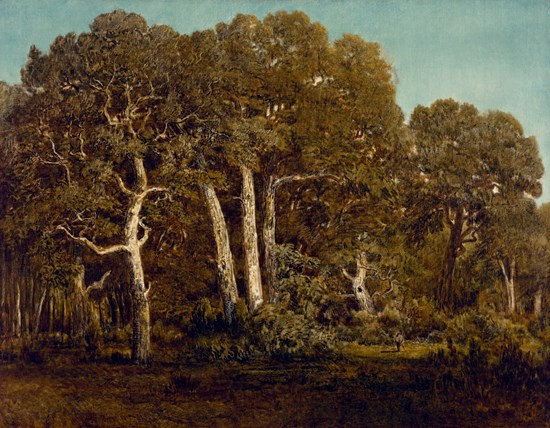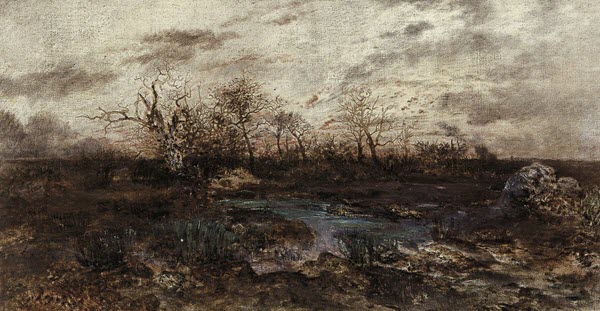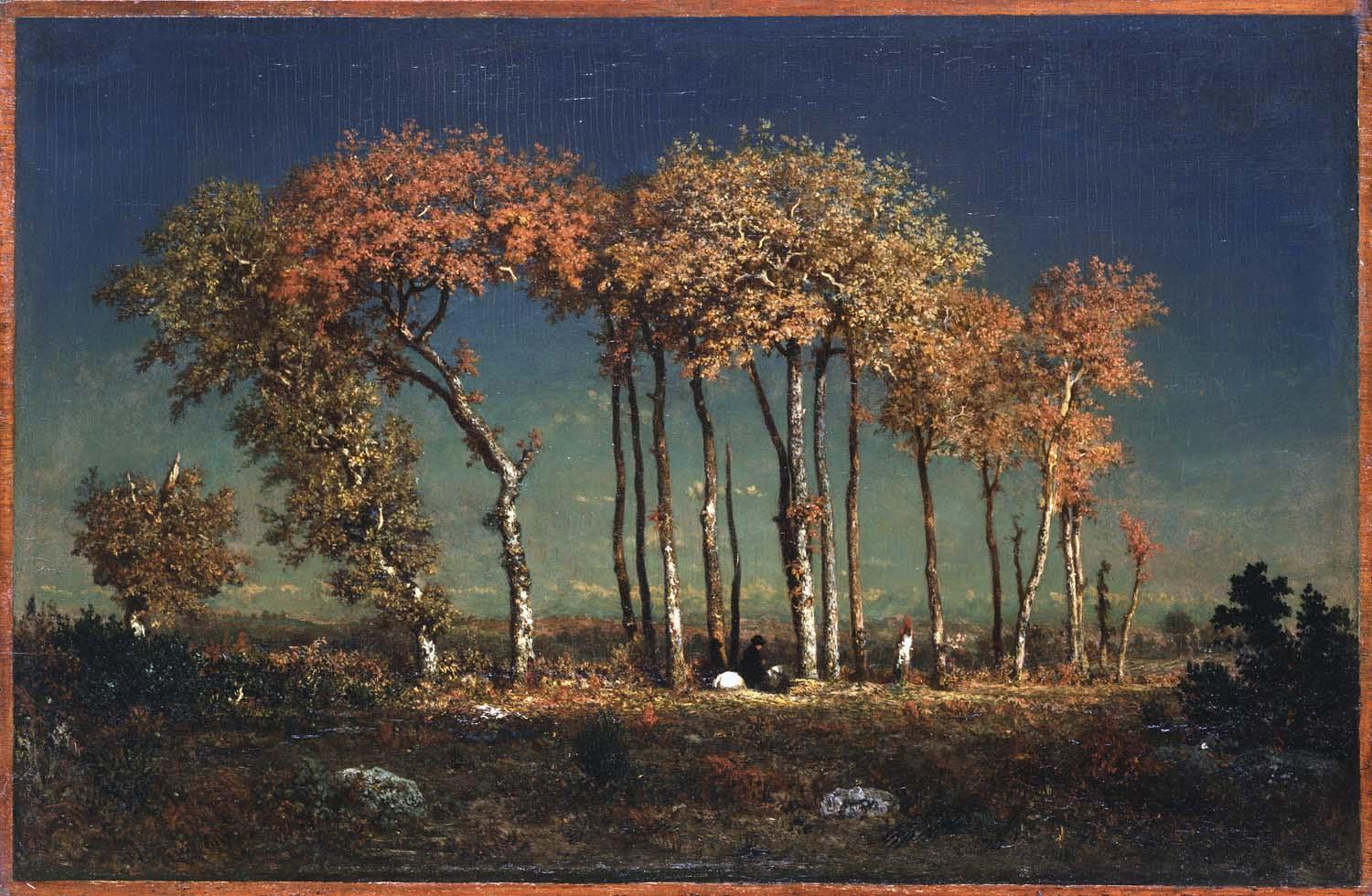This painting depicts a corner of the forest of Fontainebleau known as Bas-Bréau, near Théodore Rousseau’s home in the village of Barbizon. An old-growth section of the forest with ancient, towering oaks, Bas-Bréau first attracted Rousseau in 1836–37, and he continued to paint in this area throughout his career. The Getty painting was assigned the date of 1847 in Michel Schulman’s 1999 catalogue raisonné,1 most likely based on the date given in the catalogue from the 1867 Cercle des Arts exhibition (where the painting bears the title Lisière du Bas-Bréau. Haute futaie donnant sur la plaine de Clairbois; large ébauche. Les vaches descendent boire à une flaque d’eau). Although Rousseau probably provided that date, he may have been working from a somewhat inaccurate memory, as the canvas on which the work is painted bears a stamp of “Debourge,” a canvas maker who ran his business in Paris from 1849 to 1855. Unlined, on its original stretcher and in its original frame, with a surface that seems to be almost entirely intact, this painting is a pristine example of a particular kind of large-scale work practiced by Rousseau from the late 1840s into the 1860s.
Although he was born in Paris and kept a fairly firm foothold in the French capital through most of his career, Rousseau devoted himself to recording the French countryside, and in particular the forest of Fontainebleau. From 1836 on, he regularly summered in Fontainebleau, returning to Paris each winter, until 1847, when he bought a house in Barbizon and settled there permanently. In paintings such as this one, he was inspired by such naturalist painters as John Constable (1776–1837), whose paintings could be seen throughout Paris in the 1820s and 30s, and by seventeenth-century Dutch landscape painters such as Jan van Goyen (1596–1656), Jacob van Ruisdael (1628 or 1629–1682), and Meindert Hobbema (1638–1709). Both models induced Rousseau to focus on everyday, unstructured aspects of observed nature. His canvases convey a sense of the urbanite’s nostalgia for the slower pace and traditional ways of rural life and the constant rhythms of weather and seasons.2 He was particularly taken with what he perceived to be the solidity and stoicism of old trees, and he produced hundreds of tree sketches in oil, pencil, and crayon.
Rousseau sketched outdoors incessantly through much of his career using a special easel and lean-to to facilitate the practice. His “finished” paintings, however, were worked up in his studio (back in Paris during the winter, or in his studio in Barbizon after his 1847 move). Given the volume of his production, there are surprisingly few cases of directly transferred compositions from his outdoor sketches to his paintings, however.3 Rousseau more likely used the process of sketching from nature as a means to immerse himself in the wilderness, an active aesthetic meditation as an end in itself. His reverence for nature, verging on pantheism, is a central motif in the Rousseau literature. In his monograph on Rousseau, Greg Thomas has developed and historicized this theme, and argues that Rousseau was an early environmental activist (in 1853, for instance, Rousseau submitted a petition to the duke de Morny, an influential politician close to Napoleon III, protesting the commercial exploitation of the trees and rocks of Bas-Bréau, and requesting its protection).4 Thomas goes on to posit Rousseau as an embodiment of what he calls an “ecological consciousness,” a rising recognition in the nineteenth century that man was not divinely separated from nature, but an animal organically integrated within it—“a manifestation of the very ‘nature’ we had thought was our opposite.”5 Thomas suggests that Rousseau’s artistic production was as much if not more about the practice of ecological awareness as it was about creating a saleable, critically acclaimed oeuvre.
Thomas’s account provides a compelling context for the Getty painting, whose expressive effect is one of freshness, immediacy, and liveliness. The foreground of earth, boulders, grass, and broken branches is barely suggested, and the dramatic focus of the canvas converges on the trunk, branches, and foliage of the central live oak, flanked by the two dead trees, whose sharp, splintered forms are evoked with quick upward-thrusting strokes. The meandering graphic shapes of the central oak’s branches, whose gnarled limbs stretch around one another toward the sky, clearly fascinated the artist. Daylight reflects off the pond and up into the trees, filtering through the foliage in an extraordinarily nuanced range of earthy greens and browns. Rousseau sketches in the composition with a thin brown medium, possibly what was called in the nineteenth century momie, over which he layers rich glazes using a variety of brush sizes and textures. He scratches and scrapes paint away to reveal lighter ground layers, as in the milky reflection on the pond, and he selectively applies impasto, mostly on the dead tree at the center. The result is a work of penetrating vitality, vibrating with the rhythmic movements of the brush, held together by a firmly conceived composition.

Seen with adequate levels of natural light, the painting requires prolonged viewing to register the extraordinary range of greens and earth tones in what at first glance seems to be a monochromatic painting. The intensity of the creamy whites illuminates the composition and instills it with a sense of atmosphere and a kind of breezy humidity. As opposed to the open space of Rousseau’s panoramic compositions and the central clearings of many of his forest scenes, the experience here is one of subdued, sensual immersion in the scene.
Barely visible are a single figure and some cows making their ghostly entrance at the right, coming around the bend and into the water. As in most of Rousseau’s presentation paintings, these beings provide animate presence but have no narrative or anecdotal purpose. The protagonists are the trees, the ancient oaks and their lively interaction with their environment, as Rousseau weaves together foliage, branches, bark, grass, rocks, earth, water, and sky. The composition is firmly centered around the live oak with secondary trees serving as a framing device at left and right, but the surface texture ripples and churns, giving the painting an uncontained character.

The Getty painting may have been started on-site, but it was certainly finished in the studio. There is an oil sketch in a private collection that depicts the same location (Schulman 1999, no. 385, where the date is given as 1850 and the dimensions as 30.5 x 48.3 cm). The sketch contains the central live oak, the patch of water, and the open plain beyond a screen of four trees. To this scene, for the Getty picture, Rousseau adds the dead oak to the right and develops the dead oak at the left, only vaguely smudged in in the sketch. In strokes visibly overlapping branches of the live tree, Rousseau includes the dead oaks for their poetic effect, enhancing the composition with their dynamic, jagged shapes. One is reminded that despite the freshness and verisimilitude of Rousseau’s landscapes, they are infused, almost always, with a profoundly Romantic temperament.
The Getty painting relates to a category referred to by some scholars in the literature as dessin-peinture, in which the artist notates the composition on-site in chalk and thin layers of paint, and then returns to the studio to enhance particular elements and pull the composition together. It was a practice developed with Jules Dupré in 1844 when the two painters traveled to Landes and worked at recording their direct impressions on location.6 This kind of painting, large in scale and sketchlike in facture, includes the Mesdag Museum’s Chopping Trees on the Ile de Croissy (1847) and Vieux chêne à Fontainebleau (1852), the Metropolitan Museum’s Soleil couchant sur la lande d’Arbonne (ca. 1863), the Cleveland Museum of Art’s Edge of the Forest at Sunset at Bas-Bréau (ca. 1860), the Museum of Fine Arts, Houston’s Great Oaks of Old Bas-Bréau (1864; fig. 1) as well as two works recently on the market, Soleil couchant sur les sables de Jean-du-Paris (ca. 1864) acquired by the Wadsworth Atheneum, and La mare aux fees, forêt de Fontainebleau (ca. 1848, private collection; fig. 2). These paintings are the seeming antithesis of the smaller, more iconic paintings by Rousseau that are defined by their meticulous, careful, highly labored facture, such as Toledo’s Under the Birches, Evening (Le curé) (1842–43; fig. 3.) and the Frick Collection’s Village of Becquigny (1857–65). And they are not always easy to date, in part because Rousseau tended to paint in a variety of levels of finish simultaneously and across his career.

Rousseau’s oeuvre is not easily divided into the nineteenth-century academic distinctions between esquisse, ébauche, and tableau. The variety of finish and facture in Rousseau’s oeuvre, not to mention the woeful state of preservation of so many of his canvases, has created a sense of mystery regarding his technique. Further confusing issues of chronology is the fact that Rousseau often kept paintings in his studio, returning to them and reworking them over the years. There is much work still to be done on Rousseau, among the most complex and prolific French painters of the nineteenth century.7
- Mary G. Morton
-
Michel Schulman, Théodore Rousseau, 1812–1867, vol. 2. Catalogue raisonné de l’œuvre peint (Paris: Les Éditions de l’Amateur, 1999), p. 227, no. 384 (ill.). ↩︎
-
See Nicholas Green, Theodore Rousseau, 1812–1867, exh. cat. (Norwich: Sainsbury Centre for the Visual Arts, 1982), and The Spectacle of Nature: Landscape and Bourgeois Culture in Nineteenth-Century France (Manchester: Manchester University Press, 1990), for a description of Rousseau’s work as an extension of the urban Romantic’s myth of the forest as pristine, primeval Nature. ↩︎
-
Schulman lists several, but makes this observation. See Schulman 1999 (note 1), p. 66. ↩︎
-
See Greg M. Thomas, “The Practice of ‘Naturalism’: The Working Methods of Théodore Rousseau,” in Barbizon: Malerei der Natur—Natur der Malerei (Munich: Klinkhardt & Biermann, 1999), and Art and Ecology in Nineteenth-Century France: The Landscapes of Théodore Rousseau (Princeton: Princeton University Press, 2000). ↩︎
-
See Thomas 2000 (note 4), p. 1. ↩︎
-
See Green 1982 (note 2), pp. 11–15, and Fred Leeman and Hanna Pennock, Museum Mesdag: Catalogue of Paintings and Drawings (Amsterdam: Van Gogh Museum, 1996), p. 386. ↩︎
-
Scott Allan’s ongoing research on the work of Théodore Rousseau informed this entry, and will result in a forthcoming exhibition and publication. ↩︎